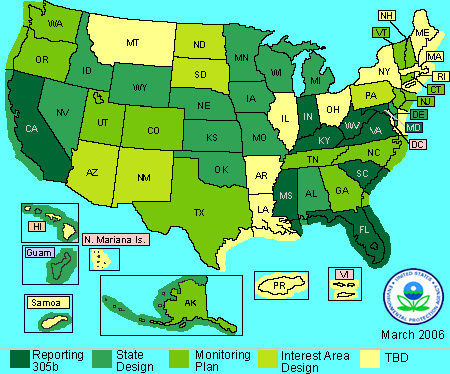Probability Monitoring Design Implementations by State
Background
Color coded implementation status of probabilistic designs in State monitoring programs:
- Reporting: Implemented State-wide and results submitted electronically to Assessment Data Base.
- Adopted: Committed to a State-wide design, implementation underway.
- Evaluating: Conducting pilot probability survey.
- Interest: State interested in evaluating probability survey design, no positive action concerning a pilot study.
- Discussion: Exploratory discussions underway evaluating potential interest in probability survey designs.
- No Interest: State has no plans to use probability survey design.
A partial list of States that have published or adopted Water Quality Monitoring Strategies and Reports that include probabilistic sampling. List includes: web sites, documents and brief program descriptions.
State web sites that the Design Team has identified can be accessed by clicking on the map or selected from list. State and Territory links not included: District of Columbia, Puerto Rico, and US Virgin Islands. Additional links to State level aquatic resources information can be found at the web site maintained by EPA Office of Water @ https://www.epa.gov/ow/states.html

These categories present State level commitments to implementation of probability based surveys. Inclusion of target population estimates in the 305(b) reports represents full implementation. The completion of a State Design, which may include initial implementation, includes States that have committed to future 305(b) reporting. States that have included a probability survey component in their published monitoring plan are depicted as "monitoring plan". States that have not committed to a State level design, but are implementing probability surveys in portions of the target population are shown as "interest area design". States that are not included in any of these four categories are shown as "TBD" and includes States that are undergoing evaluation and consideration efforts , as well as States that have implemented alternative monitoring strategies.
Note: Combining State survey results requires consistent Coverage of Target
Population, Indicators of condition or criteria for Impairment.
![[logo] US EPA](../gif/logo_epaseal.gif)